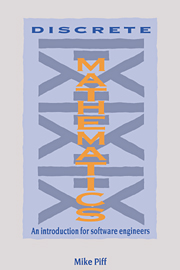2 - Logic
Published online by Cambridge University Press: 05 June 2012
Summary
Introduction
Mathematics is the science of inference. It starts from axioms describing the world, and makes deductions from those axioms according to the accepted rules of reason.
It became apparent in the nineteenth century and early in the twentieth century that these rules of inference themselves could be made the subject of mathematical investigation, and thus there was a possibility that the whole logical process could be mechanized. One could write down the initial assumptions, and then merely turn a handle to obtain the conclusion. These investigations resulted in what is known as symbolic logic. Although the original goal may have eluded us, because of certain profound discoveries concerning the process of proof, what remains is a powerful notation for expressing ideas in a precise form, and an elegant mathematical theory of logic which we shall be studying in this chapter.
Let us first look at a few places where mathematical logic is used.
Example 2.1 Whenever control branches in a computer program, a logical condition has been evaluated, and the program has branched accordingly. In higher level languages such conditions are expressed in terms of boolean values, returned whenever arithmetical comparisons such as (a<b) are evaluated. These values are combined using connectives such as AND and OR and the operation NOT, together with comparisons such as (a=b)>(c<d) working directly on the boolean values. […]
- Type
- Chapter
- Information
- Discrete MathematicsAn Introduction for Software Engineers, pp. 4 - 42Publisher: Cambridge University PressPrint publication year: 1991



